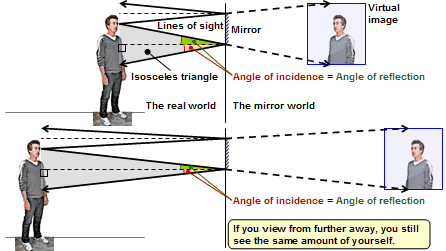
Have you ever looked in the mirror and wondered if it truly reflects your actual size? Many people believe that mirrors can make them appear larger or smaller than they are, but is there any truth to this? This article delves into the fascinating world of mirror perception, exploring the factors that influence how we see ourselves reflected. We’ll examine the role of mirror size, the angle of reflection, environmental cues, and even our own body image in shaping our perception of size.
This exploration will uncover the science behind mirror reflections and reveal the truth about whether mirrors actually make you look bigger or smaller. By understanding these factors, you can gain a clearer understanding of how your reflection truly represents you.
Mirror Size Perception
The size of the mirror itself can play a role in how we perceive our size. A large mirror might make us appear larger because it reflects more of our body, creating a wider field of view. Conversely, a small mirror might make us seem smaller because it only captures a limited portion of our reflection. This effect is similar to how a wide-angle lens on a camera can make objects appear larger and a telephoto lens can make them appear smaller.
However, it’s important to remember that the size of the mirror doesn’t actually change your physical dimensions. It simply alters the way those dimensions are presented visually. Think about standing in front of a full-length mirror versus a small hand mirror – your body remains the same size, but the reflected image changes based on the mirror’s scale.
Angle of Reflection
The angle at which you stand in relation to the mirror can also influence how you perceive your size. If you stand directly facing the mirror, your reflection will appear relatively true to size. But if you tilt your body or head slightly, your reflection might appear longer or shorter depending on the angle.
For example, tilting your head back could make your neck and torso appear longer, while tilting it forward might make your chin seem more prominent. These changes are simply a result of perspective and don’t reflect any actual alterations in your body shape. Experiment with different angles to see how they affect your reflection – you’ll notice subtle shifts in the perceived length and proportions of your body.
Environmental Influence
The environment surrounding you can also play a role in how you perceive your size. If you’re standing in a small room, your reflection might appear larger because there is less space to compare it to. Conversely, if you’re standing in a large open area, your reflection might seem smaller because there is more space to contrast it with.
Think about the difference between looking at yourself in a bathroom mirror versus standing on a beach – the surrounding environment significantly impacts how you perceive your size. These environmental cues can influence our perception of scale and proportion, making us feel larger or smaller depending on the context.
Body Image and Mirrors
Our own body image and self-perception can heavily influence how we see ourselves in the mirror. If we have negative feelings about our bodies, we might be more likely to focus on perceived flaws and exaggerate their appearance in our reflection. Conversely, if we feel confident and comfortable in our skin, we’re more likely to see a positive and accurate representation of ourselves.
It’s important to remember that mirrors reflect what is physically present, not our internal feelings or insecurities. While it’s natural to have moments of self-doubt, try to focus on your overall health and well-being rather than dwelling on perceived imperfections reflected in the mirror.
The Truth About Reflections
Ultimately, mirrors don’t make you look bigger or smaller; they simply reflect your image back to you. The perception of size can be influenced by a variety of factors, including the mirror’s size, the angle of reflection, environmental cues, and our own body image.
Understanding these factors can help us develop a more realistic and positive view of ourselves in the mirror. Remember that your true worth is not defined by how you appear in a reflection but by your inner qualities, talents, and contributions to the world.
Conclusion
Mirrors are fascinating tools that reflect both our physical appearance and our internal perceptions. While they can sometimes distort our sense of size due to various factors, it’s important to remember that the truth about reflections lies in understanding these influences and cultivating a positive body image. Embrace your unique reflection and focus on the qualities that make you truly special.
